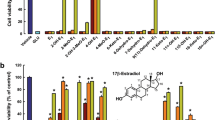Abstract
The neurotoxin quinolinic acid has been identified as a causative agent in Huntington's disease and is a metabolite of the tryptophan pathway in the brain. In the present study, the in vivo and in vitro effect of 17β-estradiol on lipid peroxidation induced by quinolinic acid was investigated. For the in vivo experiments ovariectomized female rats were administered with 100 μg 17β-estradiol daily for seven days prior to and seven days following the intrahippocampal injection of 1 μmol quinolinic acid. The level of lipid peroxidation in brain homogenate was investigated using the thiobarbituric acid test. The in vitro experiments were performed in brain homogenates of ovariectomized female rats. The homogenate was treated with quinolinic acid alone or in combination with 17β-estradiol. Quinolinic acid increased lipid peroxidation in a dose dependent manner in vitro, while homogenate co-treated with 17β-estradiol showed a significant reduction in lipid peroxidation. 17β-estradiol was also shown to be protective against quinolinic acid in vivo. These results could explain the neuroprotective effect of 17β-estradiol.
Similar content being viewed by others
REFERENCES
Ayres, S., Abplanalp, W., Liu, J., and Subbiah, R. (1998). Mechanisms involved in the protective effect of estradiol-17β on lipid peroxidation and DNA damage. Am. J. Physiol. 274:1002-8.
Behl, C., Skutella, T., Lezoualc'h, F., Post, A., Widmann, M., Newton, C., and Holsboer, F. (1997). Neuroprotection against oxidative stress by estrogens: Structure-Activity relationship. Mol. Pharmacol. 51:535-41.
Bender, D.A. (1983). Biochemistry of tryptophan in health and disease. [Review] Mol. Aspects. Med. 6:101-97.
Daya, S. (1982). The influence of sex steroids on pineal enzymes. [Msc. Thesis] pg. 74, Rhodes University, Grahamstown 6140, South Africa.
Foy, M.R., Xu, J., Xie, X., Brinton, R.D., Thompson, R.F., and Berger, T.W. (1999). 17β-Estradiol enhances NMDA receptor-mediated EPSP's and long-term potentiation. J. Neurophysiol. 81:925-29.
Goodman, Y., Bruce, A., Cheng, B., and Mattson, M. (1996). Estrogens attenuate and corticosterone exacerbates excitotoxicity, oxidative injury, and amyloid β-peptide toxicity in hippocampal neurons. J. Neurochemistry 66(5):1836-44.
Halliwell, B., and Gutteridge, J.M.C. (1995). Free radicals in biology and medicine, 2nd edition. Clarendon Press, Oxford; 188-266.
Konig, J.F.R., and Klippel, R.A. (1963). The Rat Brain. Williams and Wilkins, Baltimore, MD., 108-114.
Lowry, O.H., Rosebrough, N.J., Farr, A.L., and Randall, R.J. (1951). Protein measurement with the Folin Phenol Reagent. J. Biol. Chem. 193:265.
Moroni, F., Lombard, G., Moneti, G., and Aldinio, C. (1984). The excitotoxin quinolinic acid is present in the brain of several mammals and its cortical content increases during the aging process. Neurosci. Lett. 47:51.
Moosman, B., and Behl, C. (1999). The antioxidant neuroprotective effects of estrogens and phenolic compounds are independent from their estrogenic properties. Proc. Natl. Acad. Sci. 96:8867-72.
Ottino, P., and Duncan, J.R. (1997). Effect of α-tocopherol succinate on free radical and lipid peroxidation levels in BL6 melanoma cells. Free. Radic. Biol. Med. 22:1145.
Packer, L., and Glazer, A.N. (eds) (1990). Methods in Enzymology, vol. 186, Academic Press Inc., California, 51-85.
Rios, C., and Santamaria, A. (1991). Quinolinic acid is a potent lipid peroxidant in rat brain homogenates. Neurochem. Res. 16 1139-43.
Santamaria, A., and Rios, C. (1993). MK-801, an N-methyl-D-aspartate receptor antagonist, blocks quinolinic acid-induced lipid peroxidation in rat corpus striatum. Neurosci. Lett. 159:51-54.
Southgate, G., and Daya, S. (1999). Melatonin reduces quinolinic acid-induced lipid peroxidation in rat brain homogenate. Met. Brain Disease 14(3):165-171.
Stipek, S., Stastny, F., Platenik, J., Crkovska, J., and Zima, T. (1997). The effect of quinolinate on rat brain lipid peroxidation is dependent on iron. Neurochem. Int. 30:233-237.
Stone, T.W. (1993). Neuropharmacology of quinolinic and kynurenic acids. Pharmacol. Rev. 48:309.
Tsuzuki, K., Iino, M., and Ozawa, S. (1989). Change in calcium permeability caused by quinolinic acid in cultured rat hippocampal neurons. Neurosci. Lett. 105:269-74.
Zaleska, M.M., and Floyd, R.A. (1985). Regional lipid peroxidation in rat brain in vitro: possible role of endogenous iron. Neurochem. Res. 10:397-410.
Zar, J.H. (1974). Biostastical Analysis, 1st edition, Englewood Cliffs, NJ: Prentice Hall, 151-466.
Author information
Authors and Affiliations
Rights and permissions
About this article
Cite this article
Heron, P., Daya, S. 17β-Estradiol Protects Against Quinolinic Acid-Induced Lipid Peroxidation in the Rat Brain. Metab Brain Dis 15, 247–274 (2000). https://doi.org/10.1023/A:1011119107765
Issue Date:
DOI: https://doi.org/10.1023/A:1011119107765




